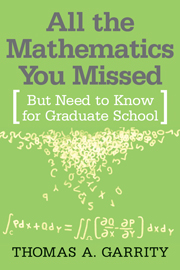Book contents
- Frontmatter
- Contents
- Preface
- On the Structure of Mathematics
- Brief Summaries of Topics
- 1 Linear Algebra
- 2 ∈ and δ Real Analysis
- 3 Calculus for Vector-Valued Functions
- 4 Point Set Topology
- 5 Classical Stokes' Theorems
- 6 Differential Forms and Stokes' Thm.
- 7 Curvature for Curves and Surfaces
- 8 Geometry
- 9 Complex Analysis
- 10 Countability and the Axiom of Choice
- 11 Algebra
- 12 Lebesgue Integration
- 13 Fourier Analysis
- 14 Differential Equations
- 15 Combinatorics and Probability
- 16 Algorithms
- A Equivalence Relations
- Bibliography
- Index
7 - Curvature for Curves and Surfaces
Published online by Cambridge University Press: 11 April 2011
- Frontmatter
- Contents
- Preface
- On the Structure of Mathematics
- Brief Summaries of Topics
- 1 Linear Algebra
- 2 ∈ and δ Real Analysis
- 3 Calculus for Vector-Valued Functions
- 4 Point Set Topology
- 5 Classical Stokes' Theorems
- 6 Differential Forms and Stokes' Thm.
- 7 Curvature for Curves and Surfaces
- 8 Geometry
- 9 Complex Analysis
- 10 Countability and the Axiom of Choice
- 11 Algebra
- 12 Lebesgue Integration
- 13 Fourier Analysis
- 14 Differential Equations
- 15 Combinatorics and Probability
- 16 Algorithms
- A Equivalence Relations
- Bibliography
- Index
Summary
Basic Objects: Curves and surfaces in space
Basic Goal: Calculating curvatures
Most of high school mathematics is concerned with straight lines and planes. There is of course far more to geometry than these flat objects. Classically differential geometry is concerned with how curves and surfaces bend and twist in space. The word “curvature” is used to denote the various measures of twisting that have been discovered.
Unfortunately, the calculations and formulas to compute the different types of curvature are quite involved and messy, but whatever curvature is, it should be the case that the curvature of a straight line and of a plane must be zero, that the curvature of a circle (and of a sphere) of radius r should be the same at every point and that the curvature of a small radius circle (or sphere) should be greater than the curvature of a larger radius circle (or sphere) (which captures the idea that it is easier to balance on the surface of the earth than on a bowling ball).
The first introduction to curvature-type ideas is usually in calculus. While the first derivative gives us tangent line (and thus linear) information, it is the second derivative that measures concavity, a curvature-type measurement. Thus we should expect to see second derivatives in curvature calculations.
- Type
- Chapter
- Information
- All the Mathematics You MissedBut Need to Know for Graduate School, pp. 145 - 160Publisher: Cambridge University PressPrint publication year: 2001



